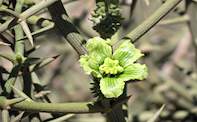
Name
Nara Plant (Acanthosicyos horridus)Introduction
The nara plant can be found growing in the dunes of Sossusvlei in the region of Walvis Bay in Namibia. These plants grow in clumps, are perennial and a part of the gourd family. Their fruit is almost spherical, yet quite oblong, and average 25 cm in diameter. The nara plant can grow up to 1.5 m in height, its roots digging deep into the sand in search of water tables. These plants are entirely leafless.
Clumps of the same sex grow and may be exposed to same-sex or opposite sex nara plants close by. They can gather sand deposits to surround them, and then grow to be above these sand deposits. New nara plants only grow when there is rainfall, quickly shooting out their newly formed roots to find a water table.
Fruit
The fruit of the nara plant is green and does not change in colour as it ages. The outer skin remains unchanged, however, the underlying flesh surrounding the seeds detaches from the skin and turns orange.
It has a very sweet in taste and has a heady scent. The fruits are spiny and mature between the months of February and April. The Topnaar people (Nama) can skillfully detect whether a nara fruit has ripened without having to break it.
Uses of the Nara Plant Fruit
To the Topnaar people (Nama), the fruit of the nara plant has two main purposes. Firstly, the seeds are taken from the fruit to be eaten as pips by splitting them open in the mouth. The second is the processing of the fruit’s pulp, which entails boiling the flesh and pouring it to form a fruit leather.
This fruit leather is eaten throughout the year, although it is much less flavourful than the pulp.The nara plant’s fruit is thereby a pertinent food source for both its flesh and seeds and can be easily stored for future consumption. Animals such as jackals and rodents eat the young fruits and seem unperturbed by the immature fruit’s bitter taste.
Nara Melons
The nara fruits, or melons, are carried by a green stem.
The stems photosynthesise, and therefore the plant is able to survive without leaves. This is advantageous as losing leaves means losing water. Because of their deep digging roots reaching for water underground, the nara plant could perhaps not be classified as a true desert plant.
The Topnaar people harvest melons in this Sossusvlei area from February to April, and August to September.
Seeds
The mature pulp of the nara plant fruit has a distinct flavour. This may be due to the sulphur components, which some Cucumis melo species contain, however this cannot be tasted. The seeds are sold in Namibia somewhat like nuts, and the pulp is used to make ice cream or coated in chocolate.
It must be considered that in commercialising the nara plants’ fruits and seeds, The Topnaar people (Nama) could be aided economically.
 South Africa has a plethora of iconic, indigenous trees that add to the beauty of South African biodiversity. SouthAfrica.co.za delivers fac...
South Africa has a plethora of iconic, indigenous trees that add to the beauty of South African biodiversity. SouthAfrica.co.za delivers fac...